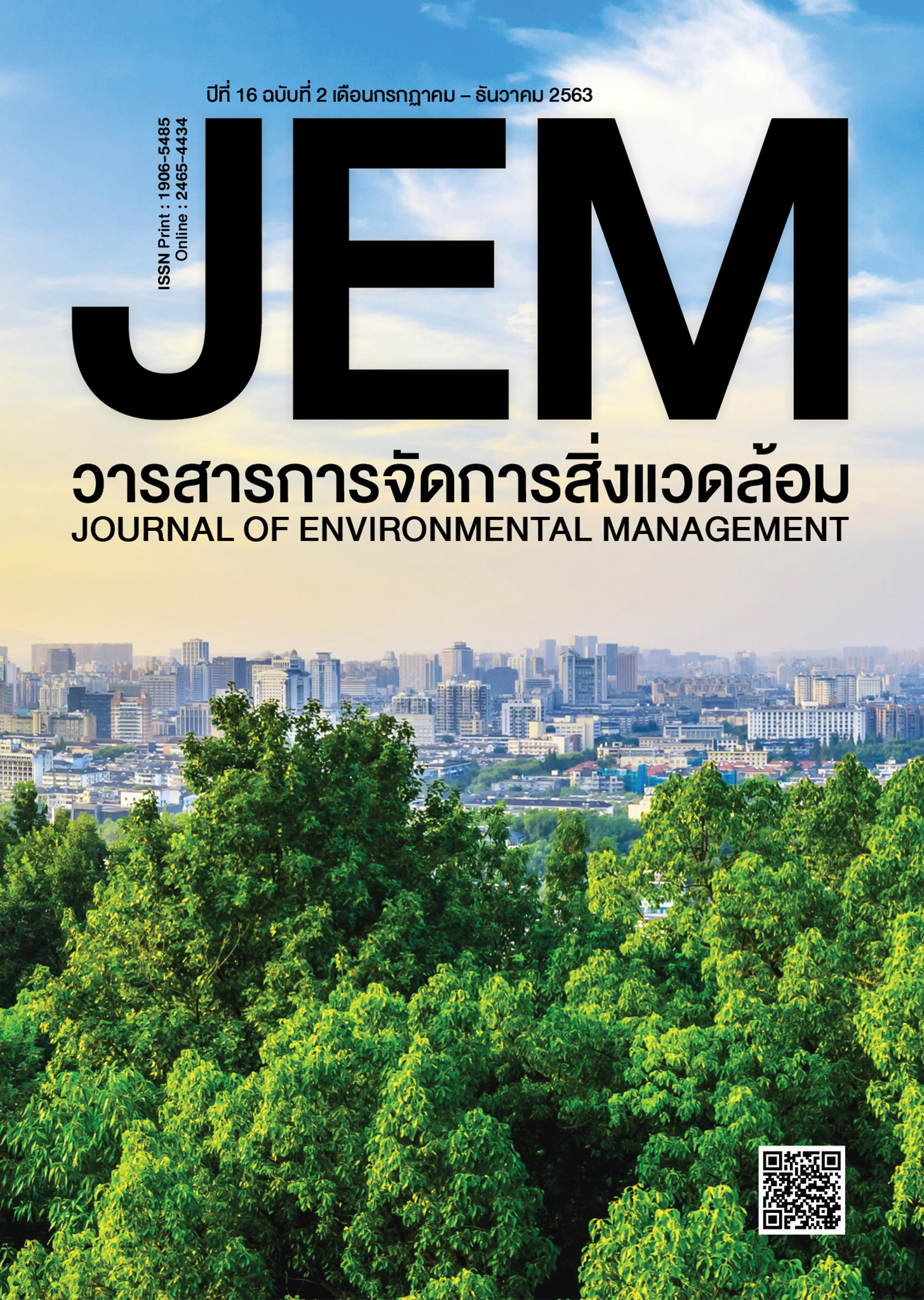สภาพแวดล้อมทางกายภาพในเส้นทางศึกษาธรรมชาติกับการรับรู้และประสบการณ์เรียนรู้ของ ผู้มาเยือนอุทยานแห่งชาติ THE PHYSICAL ENVIRONMENT IN NATURE TRAILS AND PERCEPTION AND LEARNING EXPERIENCE OF NATIONAL PARK VISITORS
DOI:
https://doi.org/10.14456/jem.2020.9คำสำคัญ:
สภาพแวดล้อมทางกายภาพ, เส้นทางศึกษาธรรมชาติ, การรับรู้, ประสบการณ์เรียนรู้, ผู้มาเยือนอุทยานแห่งชาติบทคัดย่อ
การศึกษาครั้งนี้มีวัตถุประสงค์เพื่อศึกษาสภาพแวดล้อมทางกายภาพภายในเส้นทางศึกษาธรรมชาติของ อุทยานแห่งชาติและความสัมพันธ์ระหว่างการรับรู้สภาพแวดล้อมกับประสบการณ์เรียนรู้ของผู้ใช้เส้นทาง โดยเก็บรวบรวมข้อมูลด้วยการสำรวจสภาพแวดล้อมทางกายภาพของเส้นทางศึกษาธรรมชาติร่วมกับแบบสอบถามผู้ใช้เส้นทางจำนวน 500 คน วิเคราะห์ข้อมูลการสำรวจพื้นที่ด้วยการวิเคราะห์เชิงคุณภาพและวิเคราะห์ข้อมูลจากแบบสอบถามด้วยการวิเคราะห์เชิงพรรณนา การวิเคราะห์ปัจจัย การวิเคราะห์ถดถอยพหุ และการวิเคราะห์สหสัมพันธ์ ผลการศึกษาพบว่าสภาพแวดล้อมทางกายภาพและลักษณะเฉพาะบุคคลซึ่งมีอิทธิพลทางบวกต่อการรับรู้สภาพแวดล้อม คือ องค์ประกอบทางภูมิทัศน์ ความเป็นธรรมชาติของพื้นที่ ระยะทาง แรงจูงใจในการมาเยือนพื้นที่ด้านการได้ศึกษาเรียนรู้ ความสนใจ และความรู้เดิมด้านธรรมชาติและสิ่งแวดล้อม มีค่าสัมประสิทธ์ถดถอยมาตรฐาน (beta) 0.170, 0.106, 0.101, 0.200, 0.099, 0.089 ตามลำดับ โดยการรับรู้สภาพแวดล้อมมีความสัมพันธ์ทางบวกกับประสบการณ์เรียนรู้ทุกด้าน การศึกษาครั้งนี้มีข้อเสนอแนะว่าในการจัดการสภาพแวดล้อมของเส้นทางศึกษาธรรมชาติควรให้ความสำคัญต่อปัจจัยที่ส่งผลต่อการรับรู้สภาพแวดล้อมทั้งหมดที่กล่าวมา ควรส่งเสริมให้ผู้ใช้เส้นทางได้รับรู้และเรียนรู้องค์ประกอบทางภูมิทัศน์ของเส้นทางที่โดดเด่น และควรจัดการเนื้อหา วิธีการสื่อความหมายหรือองค์ประกอบของเส้นทางที่น่าสนใจและช่วยสร้างแรงจูงใจในการเรียนรู้ การยกระดับการรับรู้สภาพแวดล้อมของผู้ใช้เส้นทางดังกล่าวจะส่งเสริมให้ผู้ใช้เส้นทางได้รับประสบการณ์เรียนรู้เพิ่มขึ้นด้วย
เอกสารอ้างอิง
Bell, P. A., Green, T. C., Fisher, J. D., & Baum, A. (2001). Environmental Psychology. 5th ed. Orlando: Harcourt College Publishers.
Bell, S. (1997). Design for Outdoor Recreation. London: E & FN Spon,
Berchez, F., Carvalhal, F., & Robim, M. D. J. (2005). Underwater interpretative trail: guidance to improve education and decrease ecological damage. International Journal of Environment and Sustainable Development, 4(2): 128-139.
Brody, M. (2005). Learning in nature. Environmental Education Research, 11(5), 603-621.
Cole, D. N., & Hall, T. E. (2009). Perceived effects of setting attributes on visitor experiences in wilderness: variation with situational context and visitor characteristics. Environmental Management, 44(1), 24.
Crawford, D. (2004). The Aesthetics of Nature and The Environment. Oxford, UK: Blackwell Publishing Ltd.
D’ Antonio, A., Monz, C., Newman, P., Lawson, S., & Taff, D. (2012). The effects of local ecological knowledge, minimum-impact knowledge, and prior experience on visitor perceptions of the ecological impacts of backcountry recreation. Environmental Management, 50(4), 542-554.
Dorwart, C. E., Moore, R. L., & Leung, Y. F. (2009). Visitors' perceptions of a trail environment and effects on experiences: A model for nature-based recreation experiences. Leisure Sciences,
(1), 33-54.
Emmons, K. M. (1997). Perceptions of the environment while exploring the outdoors: a case study in Belize. Environmental Education Research, 3(3), 327-344.
Emphandhu, D., Wannalert, S., & Ruschano, R. (2004). Guide to The Classification of Ecotourism Zoning by Recreation Opportunity Spectrum (ROS) [In Thai]. Bangkok: Tourism Authority of Thailand.
Gundersen, V., & Vistad, O. I. (2016). Public Opinions and use of various types of recreational infrastructure in boreal forest settings. Forests, 7(6), 113.
Heimlich, J. E. (1993). Nonformal environmental education: toward a working definition. The Environmental Outlook. ERIC/CSMEE Informational Bulletin, 2-9.
Herzog, T. R. (1984). A cognitive analysis of preference for field‐and‐forest environments. Landscape Research, 9(1), 10-16.
Horayangkura, V., Settaworakit, B., & Klinmalai, S. (2011). Environmental Psychology: A Basis for Creation
and Management of Livable Environment [In Thai]. Bangkok: G.B.P Center.
Hughes, M., & Saunders, A. M. (2002). Impact of trail-side interpretive signs on visitor knowledge. Journal of Ecotourism, 1, 122-132
Jarupakorn, A., & Lertvicha, P. (2008). Brain Learning Knowing [In Thai]. Bangkok: Institute for gifted and innovative learning (GIL).
Kaplan, R., & Kaplan, S. (1982). Cognition and Environment: Functioning in An Uncertain Word. New York: Praeger publishers.
Kaplan, R., & Kaplan, S. (1989). The experience of nature: A psychological Perspective. New York: Cambridge University Press.
Kaymaz, I.C. (2012). Landscape Perception. In M. Ozyavuz, eds. Landscape Planning. InTech. Retrieved January 26, 2016 from http://www.intechopen.com/books/landscapeplanning/landscapeperception.
Kearney, A. R., Bradley, G. A., Petrich, C. H., Kaplan, R., Kaplan, S., & Simpson-Colebank, D. (2008). Public perception as support for scenic quality regulation in a nationally treasured landscape. Landscape and Urban Planning, 87(2), 117-128.
Kollmuss, A., & Agyeman, J. (2002). Mind the gap: why do people act environmentally and what are the barriers to pro-environmental behavior?. Environmental education research, 8(3), 239-260.
Kalkan, S., & Demirbas, E. (2017). An empirical assessment on environmental awareness of school managers and teachers as stakeholder of private schools. Research Journal of Business and Management, 4(3), 310-325.
Lakanawarakul, R. (2011). Guidline of preparation nature trail [In Thai]. Bangkok: National Park, Wildlife and Plant Conservation Department.
Meechart, W. (2008). Public Organization Management Behavior. 2nd ed. Bankok: Chulalongkorn university press.
Nunnally, J. C., & Bernstein, I. H. (1994). Psychometric theory. 3rd ed. New York: McGrawHill.
Ode, A., Fry G., Tveit, M. S., Messager, P., & Miller, D. (2009). Indicators of perceived naturalness as drivers of landscape preference. Journal of Environmental Management, 90(1), 375-383.
Oku, H., & Katsue, F. (2006). The differences in scenic perception of forest visitors through their attributes and recreational activity. Landscape and Urban Planning, 75, 34-42.
Simonic, T. (2003). Preference and perceived naturalness in visual perception of naturalistic landscapes. Journal of Biotechnology, 81(2), 369-387.
Srisawat, l. (2015). Cognition [In Thai]. Bangkok: Odeon store publisher.
Taweerat, P. (1997). Research in Behavioral and Social Sciences [In Thai]. 7th ed. Bangkok: Educational and psychological test bureau, Srinakharinwirot university prasarnmit.
Tuntates, U. (2011). A Study on Landscape Perception of Visitors to Doi Suthep-Pui National Park [In Thai]. Unpublished Master’s thesis, Kasetsart University.
Turner, R. C., & Carlson, L. (2003). Index of Item-Objective Congruence for Multiple Objective Measure. International Journal of Testing, 3(2), 163-171.
Vanichbuncha, K., & Vanichbuncha, T. (2016). Using SPSS for Windows to Analyze Data [In Thai]. Bangkok: Threelada Publisher.
Vandenberg, A. E., & Koole, S. L. (2006). New wilderness in the Netherlands: An investigation of visual preferences for nature development landscapes. Landscape and Urban Planning, 78(4), 362-372.



